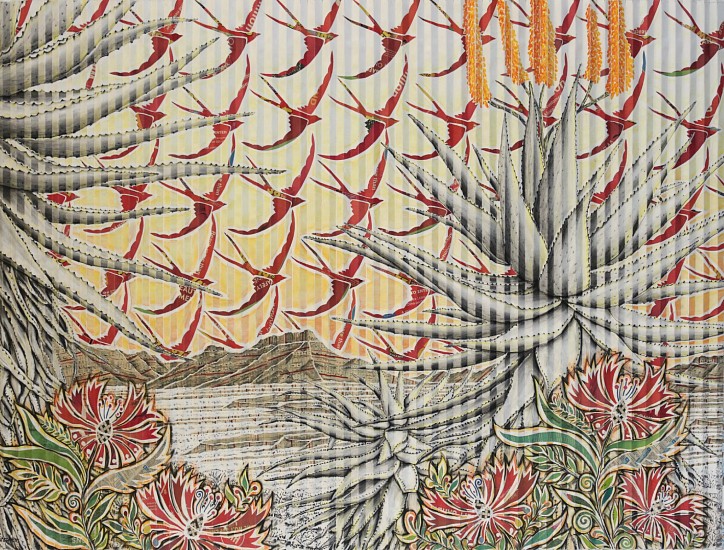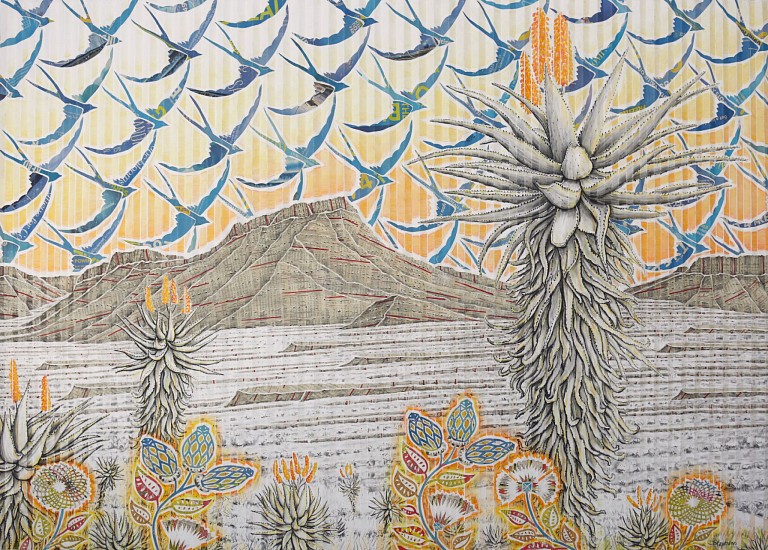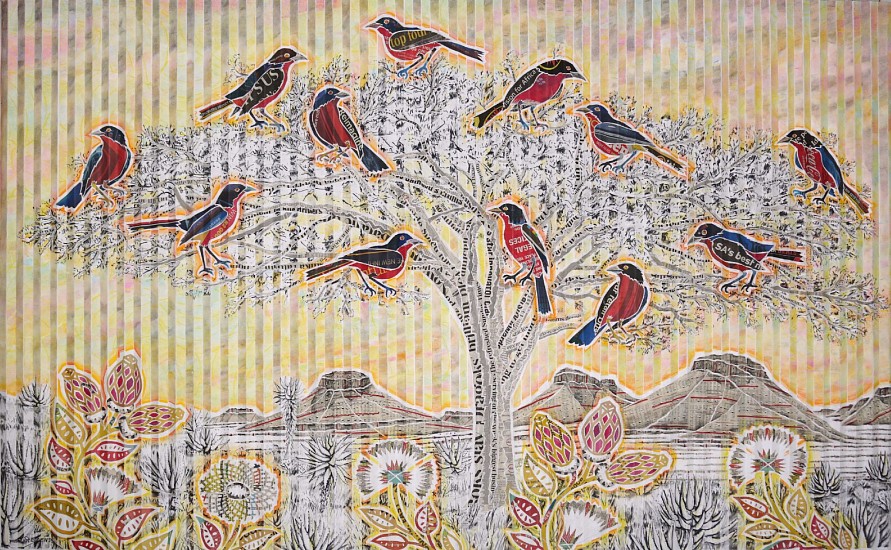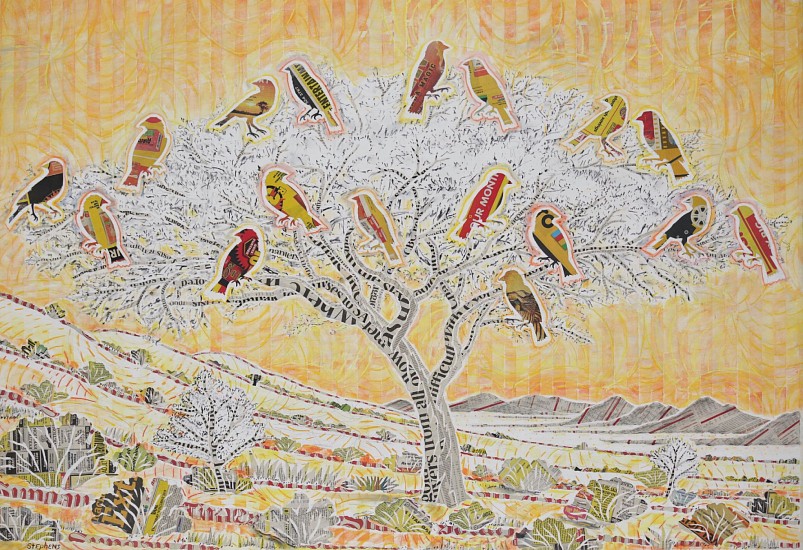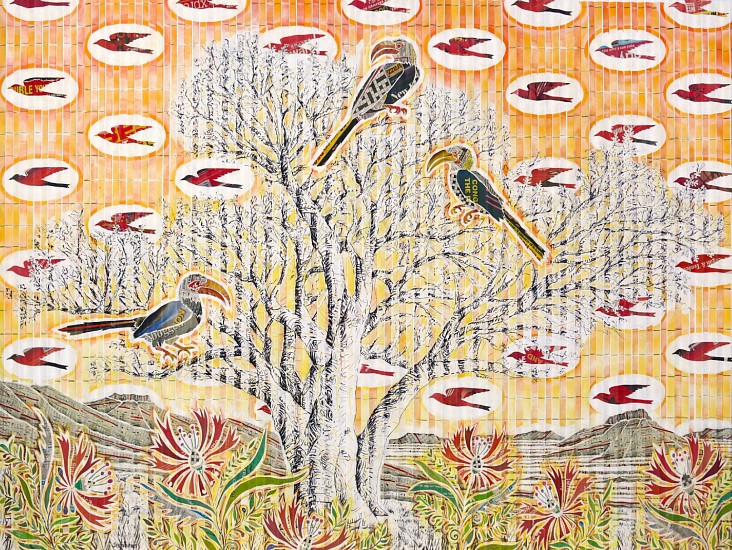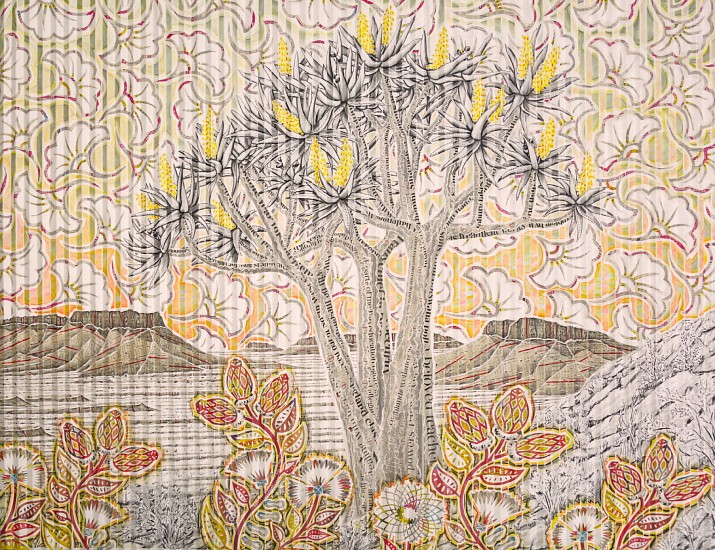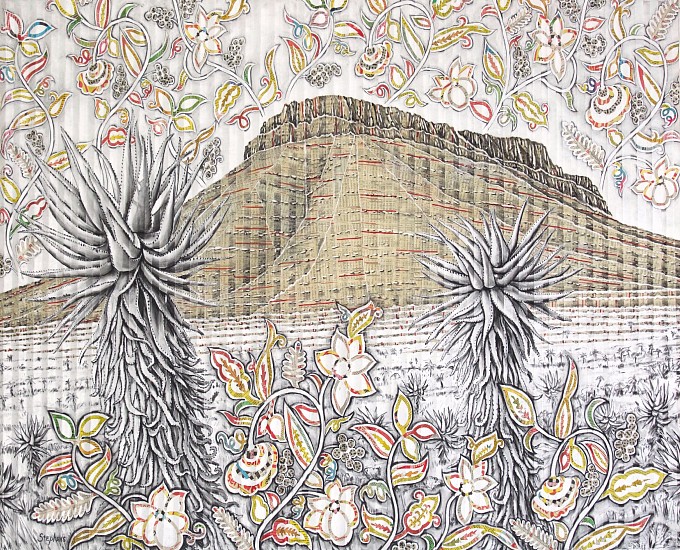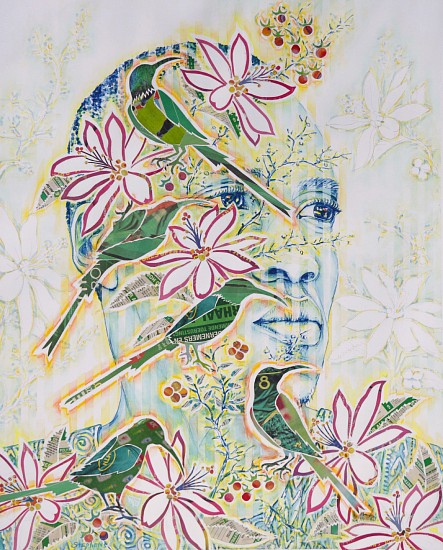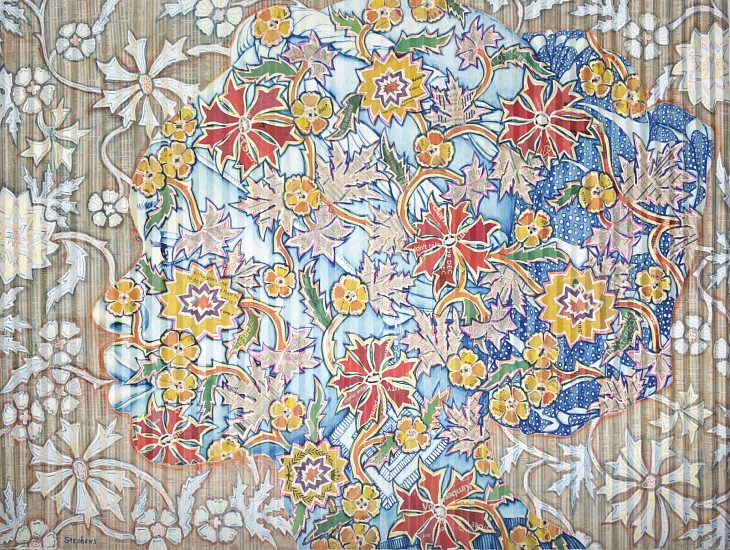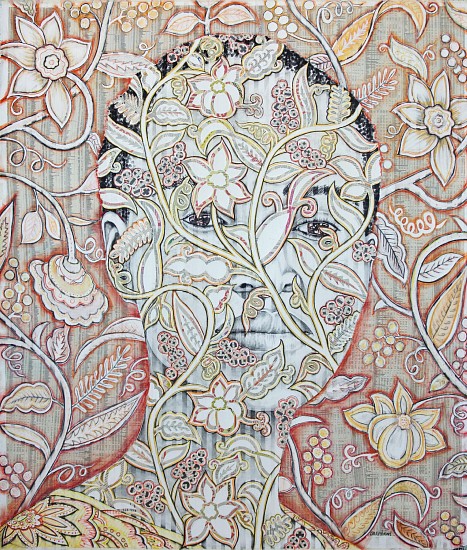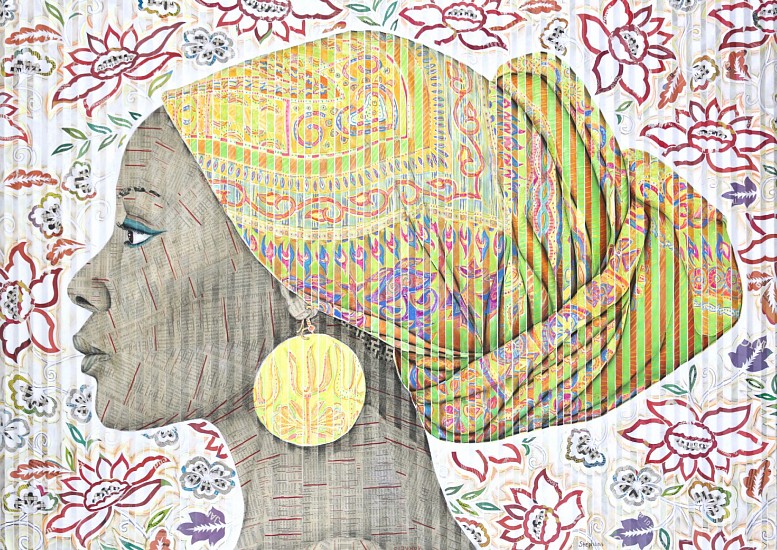GARY STEPHENS | Twilight with Red Swallows


GARY STEPHENS, Twilight Aloes with Red Swallows, Graaff-Reinet
chalk pastel, newsprint collage and charcoal on folded paper, 114 x 151 cm
Born in the Mexican border town of Yuma, Arizona, Gary Stephens studied painting and drawing at the University of Arizona and the San Francisco Art Institute. For the past thirty years, he has worked as an artist and travelled extensively in Latin America, Asia, Europe and Africa for inspiration.
A denizen of Johannesburg for the past 15 years, Stephens brings the observant power of an outsider’s eye to his subject matter. Stephens’ landscapes may be whimsical and shot through with a psychedelic sensibility of the Yellow Submarine variety, but their genesis is the artist’s profound love of remote and still places. Evocative terrain like the Kalahari and the Karoo, where ancient quiver trees bear witness to the changing seasons, rare blue swallows crowd the dawn skies, and the loud whistles of crimson breasted shrikes reverberate from acacia trees.


GARY STEPHENS, Under a Blue Swallow Sky, Graaff-Reinet
chalk pastel, newsprint collage and charcoal on folded paper, 114 x 160 cm
Born in the Mexican border town of Yuma, Arizona, Gary Stephens studied painting and drawing at the University of Arizona and the San Francisco Art Institute. For the past thirty years, he has worked as an artist and travelled extensively in Latin America, Asia, Europe and Africa for inspiration.
Stephens’ distinctive visual style encompasses African symbols and design, repeating patterns, collage and his signature, pleated paper which he deftly wields to create portraits and fantastical landscapes that pay homage to the vibrant culture and natural beauty of his adopted homeland.



GARY STEPHENS, Crimson Breasted Shrikes, Dawn Acacia
chalk pastel, newsprint collage and charcoal on folded paper, 98 x 160 cm
Born in Arizona, educated in San Francisco, with long spells in Italy and artist residencies in Lagos, and now a denizen of Johannesburg for the past 15 years, Stephens brings the observant power of an outsider’s eye to his subject matter.
Stephens’ landscapes may be whimsical and shot through with a psychedelic sensibility of the Yellow Submarine variety, but their genesis is the artist’s profound love of remote and still places. Evocative terrain like the Kalahari and the Karoo, where ancient quiver trees bear witness to the changing seasons, rare blue swallows crowd the dawn skies, and the loud whistles of crimson breasted shrikes reverberate from acacia trees.
The crimson-breasted shrike is a southern African bird. They are non-migratory and occurs in a broad swathe from southern Angola to the Free State province in South Africa and Northern Cape. Its preferred habitat is drier thornbush areas, in thickets and riparian scrub. It makes small seasonal migrations, preferring lower altitudes during cold periods.



GARY STEPHENS, Sparrow Weaver Acacia, Kalahari
chalk pastel, newsprint collage and charcoal on folded paper, 78 x 114 cm
Since 2008, Stephens has lived and worked in South Africa where he has become known for his series of monumental portraits of his artist friends and their African sense of style and dress. He combines his interests in optical effects, stripes, and repeating patterns, with his love of mark-making and uses the portrait and cityscape to explore both his visual interests and to engage with the beauty of the African continent.
Following an artist residency in 2024 at Tswalu nature reserve in the Kalahari, Stephens has returned to wild landscapes across southern Africa to photograph, sketch and coax creative renewal. His layered works bring together his explorations into non-verbal, hypnotic visual experiences and his interest in optical effects, textile patterns, geometric repetitions, and fractured images.


GARY STEPHENS, Yellow Hornbills with Sunset, Shepherd's Tree
chalk pastel, newsprint collage and charcoal on folded paper, 115 x 151 cm
Since 2008, Stephens has lived and worked in South Africa where he has become known for his series of monumental portraits of his artist friends and their African sense of style and dress. He combines his interests in optical effects, stripes, and repeating patterns, with his love of mark-making and uses the portrait and cityscape to explore both his visual interests and to engage with the beauty of the African continent.
Following an artist residency in 2024 at Tswalu nature reserve in the Kalahari, Stephens has returned to wild landscapes across southern Africa to photograph, sketch and coax creative renewal. His layered works bring together his explorations into non-verbal, hypnotic visual experiences and his interest in optical effects, textile patterns, geometric repetitions, and fractured images.
Yellow Hornbills, found in Southern Africa, live mostly in the dry, open savannas, but they are also very partial to woodlands when they can find them. When in woodlands, they seem to prefer acacia and broadleaved woodlands.
The shepherd's tree, an evergreen tree native to southern and tropical Africa, is a protected species in the caper family. It can be found in the hot, dry, and often seasonally brackish low-lying areas, sometimes on abundant lime or occasionally on rocky terrain. It is one of the most important animal forage trees in the Kalahari and is known for having the deepest known root structure of any plant at -223 ft.




GARY STEPHENS, Dawn Quiver Tree under a Flower Petal Sky
chalk pastel, newsprint collage and charcoal on folded paper, 120 x 155 cm
Born in Arizona, educated in San Francisco, with long spells in Italy and artist residencies in Lagos, and now a denizen of Johannesburg for the past 15 years, Stephens brings the observant power of an outsider’s eye to his subject matter.
Following an artist residency in 2024 at Tswalu nature reserve in the Kalahari, Stephens has returned to wild landscapes across southern Africa to photograph, sketch and coax creative renewal. With this new body of work, Stephens beckons us to join him on one of his magical, mystical journeys.
The quiver tree or kokerboom, is a tall, branching species of succulent plant, indigenous to Southern Africa, specifically in the Northern Cape province of South Africa, and part of Southern Namibia.




GARY STEPHENS, Afternoon Light on Graaff-Reinet Aloes
Charcoal and newsprint collage on pleated paper, 114 x 140 cm
Gary Stephens’ landscapes pay homage to Africa and focus attention on symbols of African life.
In 2009 he undertook a year-long residency at Greatmore Studios in Cape Town. Since then
Stephens has been living and working in South Africa – where his work began on a series of
monumental portraits of his artist friends and their African sense of style and dress. With an
outsider eye and fresh appreciation of his adopted home, he combines his interests in optical
effects, stripes, and fractured images, with his love of pattern and mark-making, and uses the
portrait and landscape to explore both his visual interests and to engage with the beauty of
the African continent.
Graaff-Reinet is a town in the Karoo (Eastern Cape Province of South Africa). Was established by the Dutch East India Company in 1786 (after Cape Town in 1652 & Stellenbosch in 1679). The town is named after then-governor of the Cape Colony, Cornelis Jacob van de Graaff, and his wife Reynet. The town was originally established as a trading post to expand trading inland from the Cape Colony.


GARY STEPHENS, Paul with Malachite Sunbirds
Chalk pastel and newsprint collage on paper, 70 x 60 cm
Born in the Mexican border town of Yuma, Arizona, Gary Stephens studied painting and drawing at the University of Arizona and the San Francisco Art Institute. For the past thirty years, he has worked as an artist and travelled extensively in Latin America, Asia, Europe and Africa for inspiration.
A denizen of Johannesburg for the past 15 years, Stephens brings the observant power of an outsider’s eye to his subject matter. Stephens’ landscapes may be whimsical and shot through with a psychedelic sensibility of the Yellow Submarine variety, but their genesis is the artist’s profound love of remote and still places.
The malachite sunbird is a small nectarivorous bird found from the highlands of Ethopia southwards to South Africa. They pollinate many flowering plants, particularly those with long corolla tubes, in the Fynbos, a small belt of natural shrubland or heathland vegetation located in the Western Cape and Eastern Cape provinces of South Africa.


GARY STEPHENS, Blue Leticia with Polkadot Scarf
chalk pastel and newsprint collage on folded paper, 114 x 151 cm
Stephens is best known for his monumental portraits which celebrate an urban African sense of style and fashion, manifest in the cities and communities where he has, over time, become a local.
Born in Arizona, educated in San Francisco, with long spells in Italy and artist residencies in Lagos, and now a denizen of Johannesburg for the past 15 years, Stephens brings the observant power of an outsider’s eye to his subject matter. Stephens’ distinctive visual style encompasses African symbols and design, repeating patterns, collage and his signature, pleated paper which he deftly wields to create portraits and fantastical landscapes that pay homage to the vibrant culture and natural beauty of his adopted homeland.


GARY STEPHENS, Rachel Facing Forward
Chalk pastel and newsprint collage on paper, 133 x 114 cm
Gary Stephens’ landscapes pay homage to Africa and focus attention on symbols of African life.
In 2009 he undertook a year-long residency at Greatmore Studios in Cape Town. Since then Stephens has been living and working in South Africa – where his work began on a series of monumental portraits of his artist friends and their African sense of style and dress. With an outsider eye and fresh appreciation of his adopted home, he combines his interests in optical effects, stripes, and fractured images, with his love of pattern and mark-making, and uses the portrait and landscape to explore both his visual interests and to engage with the beauty of the African continent.


GARY STEPHENS, Buyane with Chartreuse Scarf
chalk pastel, newsprint collage and charcoal on folded paper, 114 x 160 cm
Born in the Mexican border town of Yuma, Arizona, Gary Stephens studied painting and drawing at the University of Arizona and the San Francisco Art Institute. For the past thirty years, he has worked as an artist and travelled extensively in Latin America, Asia, Europe and Africa for inspiration. In 1998, he moved to Florence, Italy, where he lived and worked for ten years refining his drawing style.
Since 2008, Stephens has lived and worked in South Africa where he has become known for his series of monumental portraits of his artist friends and their African sense of style and dress. He combines his interests in optical effects, stripes, and repeating patterns, with his love of mark-making and uses the portrait and cityscape to explore both his visual interests and to engage with the beauty of the African continent.











Specialists in contemporary art from South Africa. Established in 1913. South African artists are part of the global conversation. We seek to make their voices heard.

